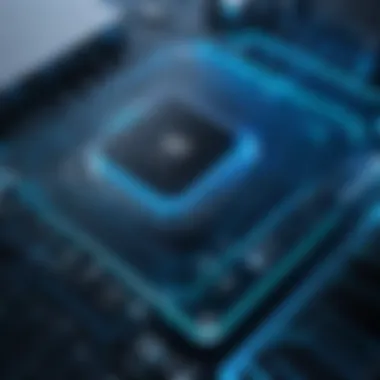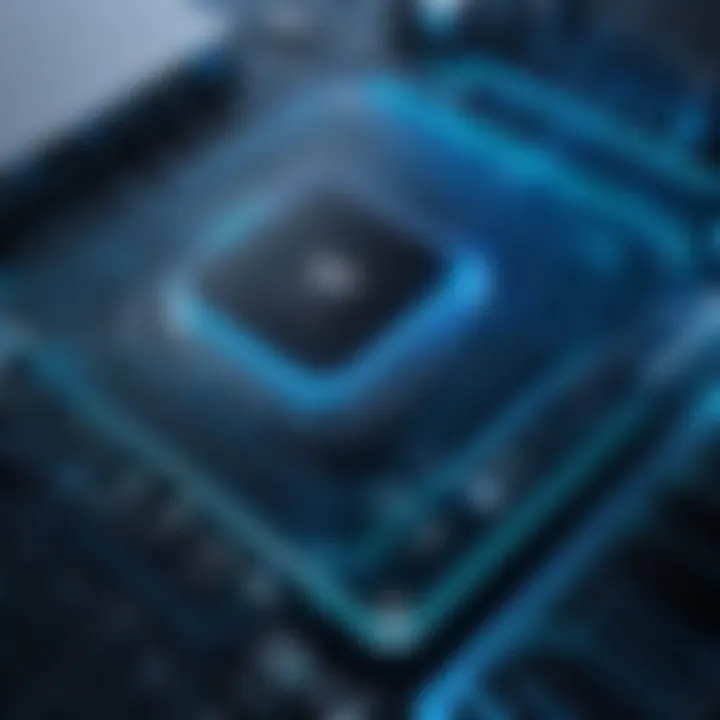Exploring the Edge Platform: Transforming Digital Infrastructure


Intro
In a world where data reigns supreme, the edge platform is carving out its territory, fundamentally reshaping digital infrastructure. The concept of edge computing hinges on the idea of processing data closer to where it is generated, as opposed to relying solely on centralized data centers. This paradigm shift not only optimizes efficiency but also addresses crucial aspects such as latency, bandwidth, and security. Understanding this concept is essential for IT professionals, cybersecurity experts, and students alike, as it paints a picture of the future of digital infrastructure.
This exploration covers various dimensions of edge platforms, beginning with foundational concepts around storage, security, and networking. It then meanders through the benefits and challenges inherent in adopting edge computing technologies, while also casting a wide net over practical applications across different industries. As we dive deeper, we will unpack emerging technological trends and possible future directions, providing our audience with a comprehensive toolkit to navigate this evolving landscape.
Understanding Storage, Security, or Networking Concepts
Prelude to the Basics
At the core of edge computing are three critical elements: storage, security, and networking. Understanding these elements is like having the key to a vast and intricate lock. Storage refers to ways data is kept and retrieved, whether on physical servers or in cloud-based environments. Security, on the other hand, tackles the necessity of protecting sensitive information from unauthorized access or breaches. Finally, networking encapsulates the connection pathways that enable data flow between devices and systems.
Key Terminology and Definitions
Navigating this domain demands familiarity with specific terminology:
- Edge Device: A piece of hardware that sits at the edge of the network, handling preliminary data processing.
- Latency: The time it takes for data to travel from its origin to a destination and back.
- Throughput: The volume of data transmitted successfully over a network in a given time frame.
Overview of Important Concepts and Technologies
The edge platform operates on several foundational technologies that enhance its functionality:
- IoT (Internet of Things): Devices interlinked through the internet, contributing to the massive datasets processed at the edge.
- 5G Connectivity: Offering high-speed internet that dramatically reduces latency, this technology bolsters edge computing.
- Data Analytics: Tools that examine data at the edge, generating insights that can inform business strategies and operational efficiencies.
In sum, these elements and definitions set the stage for a deeper understanding of edge computing.
Prologue to Edge Platform
The world is buzzing about digital innovation and the era of edge computing. Understanding the edge platform means grasping not just a buzzword, but a vital component reshaping our technological landscape. It brings computation closer to where data originates, which isn't just a nice-to-have; it's becoming essential in today's fast-paced environment.
The significance of the edge platform lies in its ability to enhance data processing speeds and reduce response times. Think about how livestreaming or real-time analytics work; they hinge on this technology. The faster data can be processed, the better decisions can be made – whether in healthcare, industrial automation, or smart cities.
Definition and Core Concepts
So, what exactly is the edge platform? At its essence, it refers to a distributed computing paradigm that moves data processing closer to the data source. A simple definition can be: computing that happens at the edge of the network rather than relying on a centralized data center. This approach tackles several core concepts:
- Proximity to Data: Reduced distance means quicker data retrieval and processing. Less latency is not just a technical term; it often translates into a better user experience.
- Real-Time Data Processing: Edge computing allows for immediate data analytics, which is crucial for operations like monitoring public safety or optimizing supply chains. It turns raw data into actionable insights almost instantly.
- Resource Optimization: By filtering and processing data locally, it offloads bandwidth from core systems. This can lead to significant savings and reduce the risk of bottlenecks.
Such foundational aspects provide a solid groundwork for understanding the edge platform's potential.
Historical Context of Edge Computing
Now, let’s take a quick stroll down memory lane. The concept of edge computing isn’t new; it has roots that stretch back into the early days of network computing. Initially, the industry focused on centralizing resources, leading to a structure where all data had to travel to a distant data center. Over time, organizations began to realize that this model came with limitations, especially as the volume of data generated skyrocketed.
Around the onset of the 21st century, the exponential growth of IoT devices marked a turning point. Suddenly, large data streams required as close to instantaneous processing as possible – waiting minutes for data to travel hundreds of miles just wasn’t cutting it. This was where edge computing gained traction.
In recent years, the arrival of 5G technology has been a game changer, as it allows not only faster transfer speeds but also enables more devices to connect seamlessly. With powerful connectivity, edge platforms can reach their full potential and play a pivotal role in modern data architecture.


"Edge computing enables a more efficient digital ecosystem by balancing loads and enhancing processing capabilities directly at the data source."
In summary, the edge platform offers essential benefits that align with current technological demands. Understanding its historical context helps to appreciate its evolution and the remarkable changes it's driving in industries today.
Architecture of Edge Platforms
Understanding the architecture of edge platforms is paramount for grasping how they enhance digital infrastructure. It serves as the backbone, determining how efficiently data can be processed and transmitted closer to its source, as opposed to being relayed to centralized data centers. This shift not only optimizes operational speed but also directly influences latency reduction and overall performance. By delving into this architecture, we can appreciate its benefits in real-world applications and the considerations that come into play when designing such frameworks.
Components of an Edge Framework
The components that make up an edge framework are multifaceted. Essentially, they can be boiled down to three critical elements: edge devices, edge servers, and the network connectivity that binds them all together.
- Edge Devices: These include sensors, IoT devices, and gateways that collect and process data at the point of origin. They play a crucial role in the edge ecosystem by minimizing data movement and facilitating real-time processing.
- Edge Servers: Positioned closer to the data source, these servers handle significant amounts of processing before data is sent to the central servers or cloud. They execute computations, storage, and analysis, thus reducing the bandwidth needed for data transfer.
- Network Connectivity: The efficiency of edge platforms also relies heavily on the quality and speed of network connectivity. Low-latency connections, often facilitated by 5G or dedicated fiber links, are essential to ensure seamless data flow between devices.
Each of these components works synergistically, creating an integrated framework that maximizes performance and efficiency. The architectural design of these systems must account for scalability, device management, and rapid deployment, making them adaptable to various environments.
Network Topology Considerations
When we explore network topology in edge architecture, we need to consider how different arrangements impact data flow and processing efficiency. Several topological models can fit within the edge computing paradigm.
- Star Topology: In this model, all devices connect to a central hub. This approach simplifies management and improves data distribution but can create a single point of failure.
- Mesh Topology: Each device has direct connections to every other. This design offers robustness since it doesn’t rely on any single connection but can become complex and harder to manage.
- Hybrid Topology: A blend of star and mesh topologies, this model allows for flexibility in deployment and encourages load balancing among devices, ensuring optimal resource use without overwhelming any single node.
An effective network topology will depend on specific use cases. For example, a smart city’s edge framework might benefit from a hybrid approach, utilizing the robustness of mesh for city-wide sensors while maintaining a star configuration for critical traffic management nodes.
In summary, the architecture of edge platforms significantly affects their performance and capability. By understanding the components and considering effective network topologies, organizations can tailor solutions that meet their unique requirements, ensuring they stay at the forefront of technology advancements.
"The design and scalability of edge architecture can be as crucial as the performance itself—navigating this landscape thoughtfully can yield immense advantages in data-driven decision-making."
Finally, the collective harmony of components and topology will dictate how edge platforms not only function but also how they can evolve to embrace the increasing demands of a growing digital ecosystem.
Advantages of Edge Computing
The adoption of edge computing is becoming less of a choice and more of a necessity in today's digital landscape. Organizations, regardless of size or industry, are witnessing the benefits that edge platforms bring. By processing data nearer to its source, edge computing unlocks a myriad of advantages, from faster response times to enhanced data security. Let’s delve into the key benefits that make edge computing a cornerstone of modern digital infrastructure.
Reduced Latency and Improved Speed
One of the prime advantages of edge computing is the significant reduction in latency. When data is processed closer to where it is generated, the time taken for the data to travel back and forth is cut down dramatically, almost like making a beeline instead of taking the long route. This is especially critical in scenarios where every millisecond counts, such as in automated trading systems or online gaming.
Consider a smart factory where machines communicate to optimize production lines. By employing edge computing, any hiccup in the system can be addressed almost instantaneously, keeping things running smoothly without unnecessary downtimes.
Additionally, improved speed enhances user experience tremendously. Imagine video streaming services buffering less frequently or video calls occurring without annoying lags. The benefits are tangible; businesses can maintain customer satisfaction and operational effectiveness.
Enhanced Data Security
Data security is a growing concern in a world increasingly reliant on digital technologies. Edge computing can bolster security measures by limiting the data that needs to be transmitted back to a central cloud server. This not only reduces the volume of data that could potentially be intercepted during transmission but also minimizes the attack surface.
For instance, in healthcare, patient data can be processed locally on the devices rather than being sent over the internet to distant servers. This localized processing keeps sensitive information more secure. Companies using edge systems also benefit from having more control over their data, ensuring compliance with increasingly stringent data protection regulations.


"Data security isn’t just a necessity; in the edge computing arena, it’s a priority that can define a company’s resilience against cyber threats."
Operational Efficiency and Scalability
Operational efficiency is another vital advantage of edge computing worth noting. Edge platforms can handle enormous amounts of data without overwhelming centralized systems. By distributing processing tasks across multiple edge nodes, organizations can enhance their workloads without needing to invest heavily in additional centralized infrastructure.
Moreover, scalability becomes a straightforward process. As businesses grow, adding new edge devices and nodes can expand processing capabilities without interruptions. This method differs from traditional cloud systems, where scaling often involves intricate planning and considerable investment.
A prime example of this can be found in retail. Stores equipped with edge devices can analyze real-time customer behavior patterns and adjust inventory accordingly. Such insights lead to better stock management and ultimately drive sales, giving businesses an edge (pun intended) over their competitors in quick decision-making.
Challenges Faced by Edge Platforms
The transition to edge computing is not without its hurdles. Each new technology comes with a set of challenges, and edge platforms are no different. Understanding these challenges is crucial for any organization looking to harness the potential of edge computing. These challenges often stem from a mix of technical, infrastructural, and regulatory factors that can complicate the implementation and proliferation of edge technologies. Here we will explore some of the primary challenges faced by edge platforms, emphasizing their significance in shaping the digital landscape.
Technical Limitations
While edge computing offers many benefits, it also grapples with limitations. One significant aspect is the hardware dependency. Edge devices, often located far from centralized servers, need to process and store data locally. The performance and capabilities of these devices can significantly influence overal system efficiency. Many legacy devices may not possess the computational power necessary to process large volumes of data efficiently. This often results in challenges in scaling and adopting new technologies.
Additionally, bandwidth constraints present another layer of complexity. In areas with limited connectivity, transmitting data from edge devices to cloud systems can be slow or unreliable, leading to delays and potential data loss. This lack of consistent connectivity could undermine the real-time processing capabilities that edge computing promises. Moreover, as more devices get connected at the edge, managing these devices, ensuring compatibility, and securing the data they handle can become a daunting task.
Integration with Legacy Systems
The legacy systems prevalent in many organizations pose a significant roadblock when companies aim to implement edge computing solutions. Many businesses operate on outdated infrastructures designed for previous computing paradigms. Incorporating edge platforms often entails integrating them with these old systems, which can be both technically and financially challenging.
To elaborate, consider an organization relying on traditional data centers that are not inherently equipped to communicate with edge devices. The cost of upgrading these systems can be prohibitive. Not to mention, there may be a steep learning curve for IT staff, who must gain proficiency in the new technologies being introduced. When systems don’t work together seamlessly, it can lead to data silos, where information is trapped in different corners of the network, reducing overall efficiency.
Regulatory and Compliance Issues
Compliance with regulations is another critical aspect that frequently hampers the adoption of edge platforms. Organizations are often bound by various laws that dictate how data should be processed, stored, and transmitted, especially in sensitive fields like healthcare or finance. With data being collected and processed at the edge, businesses must ensure that they are compliant with local and international regulations, such as the General Data Protection Regulation (GDPR) in Europe.
Moreover, the varying regulatory landscapes across different jurisdictions can complicate matters. A solution suited for one region might not meet the requirements in another, creating additional layers of legal and administrative hurdles.
"Navigating the regulatory maze is a key challenge. Organizations must stay abreast of evolving legislation to ensure their edge computing solutions are compliant."
In summary, while edge platforms offer exciting opportunities in terms of reducing latency and enhancing data processing capabilities, several challenges must be overcome to fully realize these benefits. From technical limitations to integration woes and regulatory hurdles, these issues merit careful consideration as organizations venture into the realm of edge computing.
Applications of Edge Platforms
The rise of edge platforms marks a significant shift in how we leverage technology in various industries. As more devices connect and the demand for real-time processing grows, edge computing has emerged as a powerful solution. Its applications span diverse fields, offering advantages such as improved efficiency, reduced latency, and enhanced data security.
Smart Cities and IoT
Smart cities are at the forefront of adopting edge platforms. By integrating the Internet of Things (IoT), cities can collect vast amounts of data from sensors distributed throughout the environment. This data serves numerous purposes: traffic management, energy consumption, and public safety, to name a few. For instance, real-time analytics can be applied to traffic signals, adjusting them dynamically based on current traffic conditions. This leads to smoother flows and less congestion.
Moreover, edge computing allows for enhanced security features in these implementations. Processing sensitive data closer to the source minimizes the risk of exposure during data transmission. With smart waste management systems, garbage bins equipped with sensors can notify collection services when they're full. This not only optimizes routes but also conserves resources.
Healthcare Innovations


In healthcare, the applications of edge platforms are truly transformative. Remote patient monitoring is one area where real-time data analysis can save lives. Devices like wearables can continuously monitor vital signs and send alerts if they detect anomalies. With edge computing, this data can be processed immediately, allowing healthcare professionals to respond quickly rather than waiting for storage in centralized data centers.
Additionally, in cases of emergencies, such as cardiac arrests, every second counts. Edge platforms can facilitate faster response times by quickly analyzing the data from these devices and alerting medical teams. The implications for personalized medicine are vast as well. Through local processing, data privacy is preserved, ensuring sensitive information remains secure.
Manufacturing and Industry 4.
Manufacturing is undergoing a renaissance with the rise of Industry 4.0, where edge platforms play a crucial role in automating processes. Edge devices in factories can monitor machinery conditions in real-time, predicting maintenance needs before a machine fails. This predictive maintenance approach minimizes downtime and maximizes productivity.
Moreover, production lines equipped with edge computing capabilities can optimize workflows based on live data. For instance, assembly robots can adjust activities based on the output of sensors detecting product anomalies. This not only enhances quality but also decreases waste. As manufacturers transition to a more data-driven mindset, the combination of IoT and edge platforms becomes invaluable in streamlining operations.
Autonomous Vehicles and Transportation
Autonomous vehicles rely heavily on real-time data processing for safe navigation. Edge computing is essential here, allowing vehicles to process information from their surroundings swiftly. This includes data from sensors and cameras that detect obstacles, traffic signals, and pedestrians.
For instance, consider a self-driving car navigating a busy intersection. It needs to adapt instantaneously to changes in traffic conditions. With edge computing, the car can process this information locally and make decisions in milliseconds, which is crucial for preventing accidents.
Furthermore, vehicle-to-everything (V2X) communication can be enhanced by edge platforms. These systems enable vehicles to communicate with each other and their environment, improving overall traffic efficiency and safety.
In summary, the versatility of edge platforms enhances efficiency, security, and real-time processing across various sectors, from urban infrastructure to healthcare and transportation.
The future of edge computing appears promising, with numerous innovations on the horizon. As industries continue to embrace this technology, its impact on digital infrastructure will be profound, reshaping how we interact with the world around us.
Future of Edge Computing
The realm of edge computing is not just a fleeting trend; it serves as a cornerstone for the digital transformations of tomorrow. As businesses and industries continue to harness data at unprecedented rates, the future of edge technology emerges as paramount for ensuring efficiency, security, and timely insights. This section explores the critical trends and potential innovations that are shaping the upcoming landscape of edge computing. It's important for stakeholders, including IT professionals, cybersecurity experts, and students, to grasp these elements as they directly influence strategic decisions and technological investments.
Trends Shaping Edge Technology
- Increased Demand for Low Latency: With applications requiring rapid response times—from augmented reality to real-time analytics—edge technology is essential. By processing data closer to its source, organizations can drastically reduce latency, enhancing user experiences.
- Growth of IoT Devices: The rise of Internet of Things devices continues unabated. As these devices generate massive amounts of data, edge computing allows for localized processing, thus alleviating bandwidth stress on central servers.
- AI and Machine Learning at the Edge: The shift toward incorporating AI and machine learning algorithms directly into edge devices has immense implications. These technologies can intelligently make decisions, analyze patterns, and predict outcomes without relying on continual cloud connectivity.
- Enhanced Security Measures: With increasing cyber threats, edge computing introduces unique security solutions. By decentralizing data processing, potential attack surfaces are minimized. Moreover, local data processing can enhance compliance with data sovereignty regulations, as data can be managed on-site rather than transmitted to distant servers.
- Collaboration across Industries: The cooperative development of edge solutions is becoming prevalent. Whether in healthcare, manufacturing, or urban development, partnerships are forging innovative applications and robust systems that leverage edge computing's capabilities.
"The future of edge computing is not just about technology; it's about enabling a smarter, more agile world that responds to our needs instantly."
Potential Innovations on the Horizon
- 5G and Beyond: As 5G technology accelerates, we can expect to see a revolution in edge computing. With higher speeds and lower latency, the capabilities for edge applications will expand, pushing towards real-time communication in various sectors such as transportation and energy management.
- Federated Learning: This innovative approach allows for machine learning models to be trained across multiple decentralized devices without sharing sensitive data. This can potentially transform how industries approach data privacy and security while benefitting from collective learning.
- Edge Robotics: The merging of robotics with edge computing can lead to autonomous systems that operate seamlessly in real-world environments. Imagine delivery drones that process data and make decisions on-the-fly, navigating complex terrains while ensuring efficiency and safety.
- Environmental Sensor Networks: The integration of edge computing into environmental monitoring could facilitate real-time analysis of climate data, potentially aiding in disaster response and offering vital insights for climate change initiatives.
- Increased Interoperability among Devices: Future edge innovations will likely focus on the seamless communication between various devices and platforms, fostering an ecosystem where devices can share data and insights effortlessly.
Culmination
The conclusion we reach at the end of this exploration highlights the profound influence edge platforms wield in shaping today’s digital infrastructure. It goes beyond just technology; it represents a pivotal shift in how we conceive data processing, storage, and security. Understanding the nuances of edge computing can provide significant insights for IT professionals, cybersecurity experts, and students, allowing them to harness its power effectively.
Recapitulating Key Insights
In the earlier sections, we’ve journeyed through the architecture, advantages, challenges, and applications of edge platforms. Here are some key points to take away:
- Reduced Latency: By processing data closer to the source, edge platforms drastically minimize delays, enhancing real-time application performance.
- Data Security: Localized data processing decreases the risk of exposure associated with cloud transfers, offering more robust security measures for sensitive data.
- Operational Efficiency: With the scalability at hand, businesses can optimize resources and streamline their operations, adapting swiftly to ever-changing demands.
- Integration Challenges: Navigating the technical limitations presented by legacy systems is vital for businesses to fully unlock the potential of edge platforms.
This recap serves as a reminder of how each element interconnects, creating a holistic view of edge computing’s capabilities and hurdles. By recognizing these insights, stakeholders can better strategize their technological deployments.
Final Thoughts on Edge Platforms
As we conclude our exploration of the edge platform, it becomes clear that the future is interwoven with this technology. From smart cities leveraging IoT to innovations in healthcare and autonomous vehicles, the applications seem limitless—and so do the potentials for growth.
However, it is crucial to approach this transformative technology with an informed mindset. Organizations must consider regulatory frameworks, compliance issues, and integration strategies carefully. Choices made now will set the stage for sustainable growth in the digital landscape.
In essence, embracing edge computing is not merely about keeping pace with technological advancement; it's about driveing innovation in ways that elevate efficiency, enhance safety, and foster creativity. Organizations ready to adapt will not only stay relevant but may well lead the charge in shaping the future of digital infrastructure.



